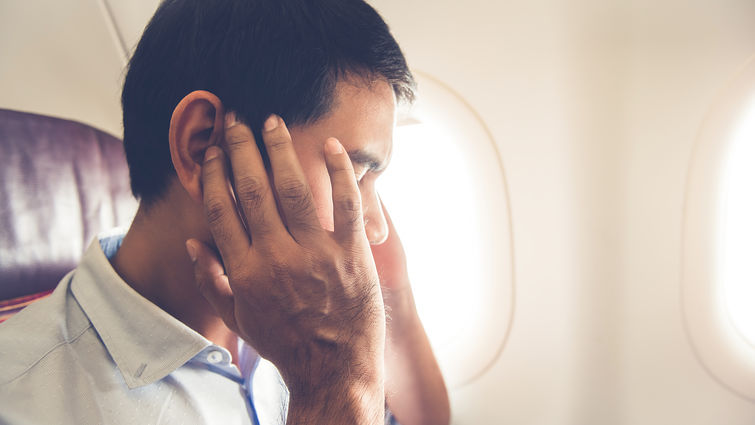
More than 25 million Americans suffer from some form of flight anxiety, making fear of flying — or aerophobia — the second biggest fear in the United States, after public speaking, according to the National Institute of Mental Health. This issue has become increasingly important as flying has become a more common a means of travel.
The Anxiety and Depression Association of America says flight anxiety usually involves several separate fears — people may be afraid of being in an enclosed space or afraid of something bad happening in the air.
"This fear often comes from feeling out of control," says Glenn Scott, LCSW, director of the youth partial hospital program at the Loma Linda University Behavioral Medicine Center. "Symptoms can be physical — such as shortness of breath, stomach pain, tightness in chest, headaches; or symptoms can be psychological — such as loss of appetite, irregular sleep patterns, anger outburst, low stress tolerance, isolating or withdrawing from regular social interactions.”
Scott provides a 7-step guide to help anxious travelers manage their flying fear:
1. Know your triggers
Figuring out what triggers the onset of fear is important in conquering flight anxiety. One flyer may be afraid of turbulence and feel panicky during takeoff, while another flyer may obsess with cleanliness and be more concerned about the spread of germs in a confined space. "The common denominator for a majority of anxious flyers is the fear that they will become overwhelmed with anxiety or suffer a panic attack during the flight and they will have no way to get to safety," Scott says. “It helps to recognize your phobia and know what triggers may cause it to spike.”
2. Check the forecast
Turbulence is a typical, unavoidable part of most flights — it happens when the plane encounters certain weather conditions such as air currents or clouds. Despite this, the idea of shaking in the air can be unnerving. Knowing what the air patterns will be like during your specific flight can help you feel prepared. There are resources online, and even apps for your phone, that can let you know if your flight is expected to encounter air pockets or thunderstorms that can cause turbulence. “The more you know about the turbulence and how much to expect, the less anxious you’ll feel,” Scott says.
3. Distract yourself
Most airlines provide entertainment like television, music channels and magazines to help distract you during the flight. These can make it easier to feel more comfortable in an uncomfortable place. Scott says if people associate these comforts with being safe at home, they can provide familiar feelings of comfort on an airplane. One of the best ways to distract yourself during a flight is to bring entertainment in which you are already immersed and are enjoying. If distractions aren’t working, try to get some sleep. Ask your doctor about a natural sleep aid such as melatonin to help you sleep for the duration of the flight.
4. Talk about it
Scott says if you're traveling with friends or family members, talk to them about what makes you nervous so they can help lessen the worry. Just be sure not to let the conversation become a contest over who has had the worst flight experience, or you risk snowballing your fear out of proportion. Sometimes just knowing others are there in case your anxiety surfaces is enough to help keep that anxiety at bay.
5. Relax before a flight
Try to relax as much as possible in the days leading up to a trip. Whether it's by doing yoga, deep breathing or meditation, learning how to calm yourself down will prove worthwhile. "Anything healthy you can do to encourage relaxation — such as deep breathing, listening to soothing music — helps," Scott says. “This is especially useful if you get nervous leading up to travel.”
6. Use a deep breathing technique
Deep breathing is important during the flight when you experience anxiety. Deep breathing relieves stress and anxiety because of its effect on the nervous system. It can also help to prevent hyperventilation. "If someone is very anxious, it is difficult to slow their breathing," Scott says. "Force yourself to breathe out for as long as you can and then take a long, deep breath." A tense posture can also heighten anxiety. Maintaining a relaxed position can help relax the entire body.
7. Embrace safety information
Knowing that you're prepared for anything can be reassuring. Try accessing and watching an airline safety video in your home so that you can know the procedures before you board the plane. Once you are on board, read the airline safety card in the seat pocket in front of you slowly and carefully. “One tool that can help when feeling anxious about a situation is asking yourself what the most realistic worst-case scenario could be and how you could respond,” Scott says. “Creating a plan can soothe your anxiety, but remember, you'll statistically never need to put it into action.”
For more helpful tips from Loma Linda University Behavioral Medicine Center, visit LLUBMC.org. To request information on behavioral health services, submit a form at LLUBMC.org/info and one of our intake coordinators will reach out to you to see if you or a loved one would be a good candidate for one of our programs.
